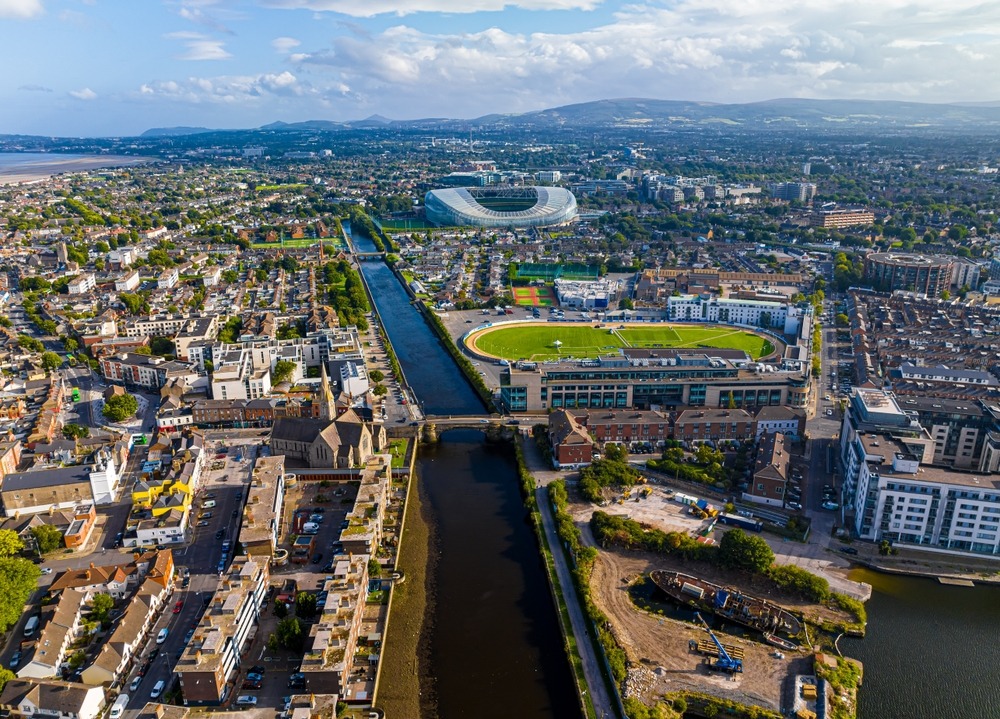A Storied City on the Liffey: The History of Dublin, Ireland
Dublin, Ireland’s vibrant capital, traces its roots back more than a millennium, developing from a modest Viking settlement into a cosmopolitan European capital. Its name is derived from the Irish “Dubh Linn,” meaning “Black Pool,” a reference to the dark tidal pool where the River Poddle met the River Liffey near Dublin Castle. Meanwhile, the older Gaelic name for the area—Baile Átha Cliath—meaning “town of the ford of hurdles,” reflects an earlier Celtic presence, predating the Norse by centuries.
In the 9th century, Dublin was established as a key Viking trading post. These Norse settlers fortified the area and laid out the foundations of a town that would become a center of commerce. By the 11th century, the Gaelic Irish and Vikings had merged, culturally and politically, giving rise to a hybrid city that continued to flourish under Norse influence until the Norman invasion of 1170. The Normans transformed Dublin into the administrative heart of English rule in Ireland, constructing walls, cathedrals, and civic buildings that still shape the city’s medieval core.
Dublin’s importance grew throughout the centuries, particularly under British rule. During the 18th century, it enjoyed a golden age, marked by the construction of grand Georgian squares and stately buildings, such as Leinster House and the Custom House. This period of elegance was cut short by the Acts of Union in 1801, which transferred political power from the Irish Parliament in Dublin to Westminster in London, causing economic and social stagnation.
Dublin reemerged as a crucible of revolution in the 20th century. The 1916 Easter Rising, a pivotal moment in the fight for Irish independence, played out on its streets, particularly around the General Post Office on O’Connell Street. This was followed by the Irish War of Independence and the eventual creation of the Irish Free State in 1922, with Dublin as its capital.
Today, Dublin is a dynamic fusion of old and new—where cobbled streets and centuries-old pubs stand alongside modern tech headquarters and contemporary art galleries. It is a city of writers, rebels, scholars, and dreamers. With deep cultural roots, a vibrant music and nightlife scene, and access to some of Ireland’s most important historical landmarks, Dublin offers a rich and rewarding experience for every traveler.

Top 25 Attractions in Dublin, Ireland
-
Trinity College and the Book of Kells – Ireland’s oldest university, founded in 1592, housing the exquisite illuminated manuscript known as the Book of Kells.
-
Dublin Castle – A historic seat of British power in Ireland with a mix of Viking, medieval, and Georgian architecture.
-
St. Patrick’s Cathedral – Ireland’s national cathedral, built in 1191, where Jonathan Swift once served as dean.
-
Christ Church Cathedral – A majestic medieval cathedral with a 1,000-year-old crypt and stunning architecture.
-
Guinness Storehouse – Dublin’s most-visited attraction, offering immersive exhibits on brewing, tastings, and panoramic views from the Gravity Bar.
-
Kilmainham Gaol – A powerful museum inside a former prison where many Irish revolutionaries, including leaders of the 1916 Rising, were imprisoned and executed.
-
The General Post Office (GPO) – A symbol of Irish independence, this building was the center of the 1916 Easter Rising and now includes a commemorative exhibit.
-
Temple Bar District – The heart of Dublin’s nightlife and cultural quarter, known for live music, pubs, galleries, and cobbled alleys.
-
Phoenix Park – One of Europe’s largest enclosed city parks, home to wild deer, Áras an Uachtaráin (the Irish president’s residence), and the Dublin Zoo.
-
Dublin Zoo – One of the oldest zoos in the world, established in 1831, located within Phoenix Park and home to over 400 animals.
-
The Little Museum of Dublin – A charming museum chronicling Dublin’s 20th-century history through personal artifacts and stories.
-
Ha’penny Bridge – A beloved cast-iron pedestrian bridge built in 1816, spanning the River Liffey with elegant curves and rich history.
-
National Museum of Ireland – Archaeology – Home to Ireland’s most precious treasures, including the Tara Brooch and Iron Age bog bodies.
-
National Gallery of Ireland – Featuring works by Caravaggio, Vermeer, and Irish masters such as Jack B. Yeats.
-
Jameson Distillery Bow St. – The birthplace of the world-famous whiskey, offering engaging tours and tastings.
-
EPIC The Irish Emigration Museum – An award-winning digital museum dedicated to the global story of Irish migration.
-
Merrion Square Park – A serene Georgian-era park surrounded by stately homes, including Oscar Wilde’s childhood home and statue.
-
Oscar Wilde Memorial and Museum – Featuring literary quotations, sculptures, and insights into Wilde’s life and legacy.
-
Irish Museum of Modern Art (IMMA) – Housed in the 17th-century Royal Hospital Kilmainham, showcasing modern and contemporary art.
-
Croke Park Stadium and GAA Museum – A celebration of Ireland’s unique Gaelic sports and the cultural significance of hurling and Gaelic football.
-
The Jeanie Johnston Famine Ship – A faithful replica of a 19th-century tall ship that carried emigrants from Ireland to North America during the famine.
-
Howth Cliff Walk – A short train ride from the city center, offering coastal trails, dramatic views, and a charming fishing village.
-
Dublin Writers Museum – Celebrating the literary history of Dublin, featuring artifacts from James Joyce, W.B. Yeats, and Samuel Beckett.
-
Dún Laoghaire and the Forty Foot – A seaside suburb perfect for a day trip, popular for sea swims, scenic walks, and its Victorian pier.
-
St. Stephen’s Green – A lush, centrally located public park ideal for relaxation, with Victorian gardens, fountains, and historic memorials.

































